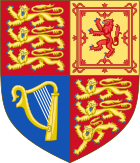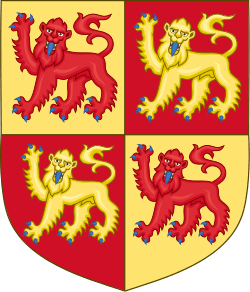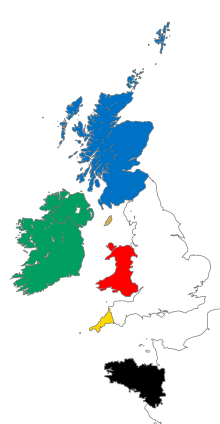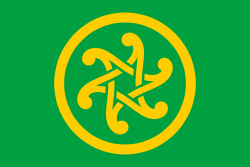Welsh nationalism
Welsh nationalism (Welsh: Cenedlaetholdeb Cymreig) emphasises and celebrates the distinctiveness of Welsh language, culture, and history, and calls for more self-determination for Wales, which might include more devolved powers for the Senedd, or full independence from the United Kingdom.
| Part of a series on the |
| Culture of Wales |
|---|
.svg.png) |
| History |
| People |
|
|
Traditions
|
|
Mythology and folklore |
|
Festivals |
| Religion |
| Art |
|
Literature
|
|
Music and performing arts |
|
Monuments
|
|
Conquest
Through most of its history before the Anglo-Norman Conquest, Wales was divided into several kingdoms. From time to time, rulers such as Hywel Dda, Gruffudd ap Llywelyn and Rhodri the Great managed to unify many of the kingdoms, but their lands were divided on their deaths. Incursions from the English and Normans also amplified divisions between the kingdoms. In the 12th century, Norman king Henry II of England exploited differences between the three most powerful Welsh kingdoms, Gwynedd, Powys, and Deheubarth, allowing him to make great gains in Wales.[1] He defeated and then allied with Madog ap Maredudd of Powys in 1157, and used this alliance to overwhelm Owain Gwynedd. He then turned on Rhys ap Gruffydd of Deheubarth, who finally submitted to him in 1171, effectively subjugating much of Wales to Henry's Angevin Empire.[1] By 1282, only Gwynedd, whose ruler was accorded the title Prince of Wales, remained independent. With the defeat of Llywelyn ap Gruffudd by Edward I Wales lost its last independent kingdom and became subject to the English crown, either directly or indirectly. It retained some vestiges of distinction from its neighbour, however, including the Welsh language, law, and culture.
Until the victory of Henry VII at Bosworth in 1485, the Welsh on many occasions revolted against English rule in an attempt to gain their independence. The greatest such revolt was that of Owain Glyndŵr, who gained popular support in 1400, and defeated an English force at Plynlimon in 1401. In response, the English parliament passed repressive measures that included denying the Welsh the right of assembly. Glyndŵr was proclaimed Prince of Wales, and sought assistance from Charles VI of France, but by 1409 his forces were scattered under the attacks of King Henry IV of England and further repressive measures imposed on the Welsh. Glyndŵr himself vanished, and his final resting place remains a mystery.
Occupation
Throughout the period of conquest the Welsh poets kept alive the dream of independence. In what was known as the canu brud (prophetic poetry), the idea was set out of the coming of a messiah-like figure, known as Y Mab Darogan (The Son of Destiny), who would not only remove the English yoke but win back the whole of Great Britain for the Britons (i.e. the Welsh).
During the reign of Henry VIII the Laws in Wales Acts were passed without any democratic mandate, annexing Wales into the English legal system. The repressive measures against the Welsh that had been in place since the revolt of Owain Glyndŵr over a century earlier were removed. These Acts also gave political representation for Wales in the Westminster Parliament. Wales continues to share a legal identity with England to a large degree as part of a joint entity incorrectly known simply as England until 1967 and England and Wales since then. The laws also finished the partitioning of Wales into counties that was begun in 1282 and established local government on the English model. The laws had the effect of making English the language to be used for all official purposes, thus effectively excluding non-English speakers from formal office.
On the whole those Welsh people who had a way of expressing an opinion welcomed these moves and saw them as further proof that Henry VII and his descendants were the long-awaited sons of destiny and that Wales had regained what it had lost at the conquest of 1282. Patriotism, or a non-politicised form of nationalism, remained a strong force in Wales, with pride in its language, customs and history common amongst all levels of society.
Revolutionary ideas
Along with the rest of Europe the effects of the French Revolution were felt in Wales. It brought to the forefront a small minority of Welsh people who sympathised with revolutionary ideas: people such as Richard Price (1723–1791), Iolo Morganwg (1747–1826), and Morgan John Rhys (1760–1804).
In the meantime, counter-revolutionary ideas flourished amongst the leaders of the Welsh Methodist revival, but the consequence of turning Wales into a nation with a nonconformist majority was to create a new sense of Welshness.
19th century
The rapid industrialisation of parts of Wales, especially Merthyr Tydfil and adjoining areas, gave rise to strong and radical Welsh working class movements which led to the Merthyr Rising of 1831, the widespread support for Chartism, and the Newport Rising of 1839.[2]
With the establishment of the Presbyterian Church of Wales, nonconformism triumphed in Wales, and gradually the previous majority of conservative voices within the church allied themselves with the more radical and liberal voices within the older dissenting churches of the Baptists and Congregationalists. This radicalism was exemplified by the Congregationalist minister David Rees of Llanelli, who edited the radical magazine Y Diwygiwr (The Reformer) from 1835 until 1865. But he was not a lone voice: William Rees (also known as Gwilym Hiraethog) established the radical Yr Amserau (The Times) in 1843, and in the same year Samuel Roberts also established another radical magazine, Y Cronicl (The Chronicle). Both were Congregationalist pastors.[3]
The growth of radicalism and the gradual politicisation of Welsh life did not include any successful attempt to establish a separate political vehicle for promoting Welsh nationalism. On the contrary Welsh nationalism weakened under the economic pressure as the coal industry of South Wales increasingly was integrated with English industry.[4] On the whole nationalism was the preserve of antiquarians, not political activists.[5]
But voices did appear within the Liberal Party, which made great gains in Wales in the 19th century with the extension of the franchise and the tacit support of Welsh nonconformity. An intended independence movement established on the pattern of Young Ireland, Cymru Fydd, was established in 1886 but was short-lived.
For the majority in Wales, however, the important question was not one of independence or self-government, but of the disestablishment of the Church of England in Wales. Nevertheless, their non-political nationalism was strong enough to establish national institutions such as the University of Wales in 1893, and the National Library of Wales and the National Museum of Wales in 1907.
Treachery of the Blue Books
Welsh nationalists were outraged by the "Reports of the commissioners of enquiry into the state of education in Wales" in 1847. The reports had blue covers, and were ridiculed as Brad y Llyfrau Gleision, or in English, "The Treachery of the Blue Books". They found the education system in Wales to be in a dreadful state; they condemned the Welsh language and Nonconformist religion. Ralph Lingen was responsible for the Blue Books of 1846. By contrast the Reverend Henry Longueville Jones, Her Majesty's Inspector of church schools in Wales between 1848 and 1865, led the opposition to subordination to the education department under Lingen. Jones's reports supported bilingual education and praised the work of many church elementary schools. They came under attack in Whitehall. Jones failed to gain full support in Wales because of his Anglicanism and his criticisms of many certified teachers.[6][7]
Influence of European nationalism
Two 19th-century figures are associated with the beginnings of Welsh nationalism in the specific political sense: Michael D. Jones (1822–1898) and Emrys ap Iwan (1848–1906). Inspired by the Revolutions of 1848 and the growth of Irish nationalism they saw that Wales was different from England in having its own language which the majority of its residents spoke and in holding to a nonconformist form of the Christian religion which faced many disabilities in the face of the state church.
20th century
Nationalism grew as an influence in 20th-century Wales. At various times both the Labour Party and the Liberal Party took up the cause of Welsh home rule, or devolution. But it was with the establishment of Plaid Cymru (The Party of Wales) in August 1925 (by David John Williams, Fred Jones, Saunders Lewis, Moses Gruffydd, H. R. Jones and Lewis Valentine) that Welsh independence from the UK was first advocated.
The Labour Party dominated politics in 1920s; it suffered a sharp setback in 1931, but maintained its hold on Wales. The leftists such as Aneurin Bevan who dominated the Party in Wales rejected nationalism as a backward reactionary movement that was more favorable to capitalism and not to socialism. Instead they wanted a strong government in London to reshape the entire state economy.[8]
The election of a Labour Government in 1997 included a commitment to hold a referendum on the establishment of a National Assembly for Wales. The referendum was narrowly won, with Plaid Cymru, the Liberal Democrats and much of Welsh civic society supporting the Labour Government's proposals.
21st century
A 2007 survey by BBC Wales Newsnight found that 20% of Welsh people surveyed favoured Wales becoming independent of the United Kingdom.[9]
In 2009 the Archbishop of Wales, Dr Barry Morgan, renewed his call for the National Assembly to be granted full law-making powers, calling for a "greater degree of self-determination" for Wales.[10]
A YouGov poll taken in September 2015 suggested that 17% of Welsh people would vote for independence.[11] Another poll by Face for Business suggests support could be as high as 28%. These are in stark contrast to the last two polls conducted by icm for the BBC which said support is as low as 5% and 3% respectively.[12]
The 2016 United Kingdom European Union membership referendum saw the voters in Wales choosing the "Leave" option by 52.5 per cent to 47.5 per cent.[13]
A Welsh Political Barometer poll, conducted for ITV-Cymru Wales and Cardiff University's Wales Governance Centre from 30 June to 4 July 2016, showed support for Welsh independence had increased following the Brexit vote. Responding to the question “And please imagine a scenario where the rest of the UK left the European Union but Wales could remain a member of the European Union if it became an independent country. If a referendum was then held in Wales about becoming an independent country and this was the question, how would you vote? Should Wales be an independent country?” the results were: Yes: 28%, No: 53% Would Not Vote/Don't Know: 20%. Removing non-committed voters, 35% of those polled would vote for independence.[14]
Plaid Cymru
Plaid Cymru was founded in the 1925. Its first Member of Parliament, Gwynfor Evans, was elected in the 1966 Carmarthen by-election, and today has four such representatives, along with eleven members of the Senedd. Historically, support for the party is concentrated in rural Welsh-speaking areas of north and west Wales, where most of its MPs have been elected. In the late 1960s and 1990s the party enjoyed surges in support.
Active nationalist parties and movements
- Cymdeithas yr Iaith Gymraeg (Welsh Language Society). Established in 1962 by members of Plaid Cymru, it is a pressure group campaigning for Welsh language rights. It uses non-violent direct action in its campaigning, and sees itself as part of the global resistance movement.
- Cymru Sovereign (also sometimes referred to as Sovereign Wales). A Welsh nationalist political party established in March 2016 that seeks Welsh independence from the United Kingdom and Welsh independence outside of the European Union (EU). The party also seeks the creation of a publicly owned Central Bank of Wales and the debt free creation of a Welsh pound currency.[15][16]
- Llais Gwynedd (Voice of Gwynedd). A regionalist party established due to dissatisfaction with Plaid Cymru in Gwynedd. It currently holds six seats on Gwynedd's local council.
- Welsh National Party. Established in 2020 by an ex member of Plaid Cymru.
Defunct nationalist parties and movements
- Cymru Goch ("Red Wales" or "Welsh Socialists"). Cymru Goch was founded in 1987 to fight for a free and socialist Wales. It published the monthly magazine Y Faner Goch (The Red Flag). In 2003, it became part of Forward Wales, which later dissolved in 2010.
- Cymuned (Community). A pressure group that campaigned for Welsh language rights established in 2001, it mainly concentrated its efforts in the western parts of Wales where Welsh is the main community language. It also saw itself as part of global movements for the rights of indigenous peoples.
- Cymdeithas Cyfamod y Cymry Rhydd (Society of the Covenant of the Free Welsh). Established in 1987, again because of unhappiness with the level of Plaid Cymru's commitment to independence. They achieved publicity by producing their own Welsh "passports".
- Mudiad Adfer (Restoration Movement) was a splinter group of Cymdeithas yr Iaith Gymraeg in the 1970s. Taking its Welsh-only philosophy from the works and teachings of Owain Owain and Emyr Llewelyn, it believed in the creation of "Y Fro Gymraeg" – a monoglot region based on the existing Welsh language heartlands in the west of Wales. Adfer slowly disappeared from the scene in the late 1980s.
- Mudiad Rhyddhad Cymru ("Cymru Liberation Movement"): A meeting took place in Flintshire on 10 January 2004 between representatives of Balchder Cymru (Wales Pride), Cymru 1400, Medi 16 (September 16), and the RDM. It was agreed at the meeting that all four organisations should amalgamate to form a stronger nationalist/republican movement. They believed that such a move would strengthen the struggle for an independent Welsh republic. The new movement has been named 'Mudiad Rhyddhad Cymru' (MRC). It aimed to campaign for an independent Welsh republic and to defend Cymru, its language and culture.
- Plaid Glyndŵr ("Party of [Owain] Glyndŵr"). Founded by Dennis Morris in 2012, the party campaigned for full independence for Wales and against colonialism in Wales.[17]
Militant nationalism
Though mainstream nationalism in Wales has been constitutional, there have been violent movements associated with it. In 1952 a small republican movement, Y Gweriniaethwyr ("The Republicans"), were the first to use violence when they made an unsuccessful attempt to blow up a pipeline leading from the Claerwen dam in mid Wales to Birmingham.[18]
In the 1960s two movements were established in protest against the drowning of the Tryweryn valley and the 1969 investiture of Charles, Prince of Wales: Mudiad Amddiffyn Cymru ("Movement for the Defence of Wales", also known as MAC) and the Free Wales Army (also known as FWA, in Welsh Byddin Rhyddid Cymru). MAC were responsible for numerous bombing attacks on water pipelines and power lines across Wales. On the eve of the investiture two alleged members of MAC, Alwyn Jones and George Taylor, died when the bomb they were planting outside a Social Security Office in Abergele exploded.
The late 1970s and the 1980s saw an organisation calling itself Meibion Glyndŵr ("sons of Glyndŵr") responsible for a spate of arson attacks against holiday homes throughout Wales. In the 1970s, a Welsh Socialist Republican Army arose, whose initials in Welsh spelt out the English word "DAWN": the Welsh Army for the Welsh Republic (WAWR).[19]
See also
- Breton nationalism (Brittany)
- Celtic Congress
- Celtic League (political organisation)
- Celts (modern)
- Cofiwch Dryweryn
- Cornish nationalism
- Cornish self-government movement
- English nationalism
- Gethin ap Gruffydd
- Irish nationalism
- Irish republicanism
- List of active autonomist and secessionist movements
- Meibion Glyndŵr
- Pan-Celticism
- Scottish independence
- Scottish nationalism
- Ulster nationalism
References
- Carpenter, David (2003). The Struggle for Mastery. Oxford University Press. pp. 213–.
- D. J. V. Jones, "The Merthyr riots of 1831." Welsh History Review= Cylchgrawn Hanes Cymru 3#2 (1966): 173.
- Richard Carwardine, "The Welsh Evangelical Community and ‘Finney's Revival’." Journal of Ecclesiastical History 29#4 (1978): 463–480.
- Henry Pelling (2016). Popular Politics & Society in Late Victorian Britain. Springer. p. 118. ISBN 9781349861132.
- Kenneth O. Morgan, Rebirth of a nation: Wales, 1880–1980 (1981). p 4
- H.G. Williams, "Longueville Jones, Ralph Lingen and inspectors’ reports: a tragedy of Welsh education." History of Education 25#1 (1996): 19–36. online
- Gareth Elwyn Jones, "Education and nationhood in Wales: An historiographical analysis." Journal of educational administration and history 38.3 (2006): 263–277. online
- Martin Pugh, Speak for Britain!: A New History of the Labour Party (2010) pp 223–24.
- "Welsh firmly back Britain's Union". BBC News. 16 January 2007. Retrieved 15 July 2009.
- "WalesOnline – News – Wales News – Archbishop of Wales Barry Morgan supports further Welsh devolution". WalesOnline website. Media Wales Ltd. 2009-07-13. Retrieved 2009-07-15.
- Tom Parmenter. "scot-vote-boosts-welsh-independence-support". sky news.
- "Face for Business Blog for Call Handling Services in the UK Blog for Call Handling Services in the UK". Face for Business. Archived from the original on 6 October 2014.
- Ellie Mae O'Hagan, "Wales voted for Brexit because it has been ignored by Westminster for too long" Independent 25 June 2016
- Prof Roger Scully (5 July 2016). "Poll shows Welsh voters now support EU membership". ITV News. Retrieved 24 July 2016.
- Cymru Sovereign (official website). Retrieved 13 June 2018.
- The Eletoral Commission - Cymru Sovereign. Retrieved 13 June 2018.
- Martin Shipman (8 January 2014). "Campaign launched against 'national disgrace' of Welsh town hall that flies the Red Dragon below the Union Flag". Western Mail. Cardiff. Retrieved 10 January 2014.
- Gruffydd, Gethin (2007-02-13). "Welsh Republican Movement 1946 – 1956: Time Line". Alternative Welsh Nationalist Archive. Retrieved 2010-09-08.
- see: Williams, Gwyn A. 'When was Wales?'
Sources/bibliography
- Clewes, Roy (1980), To dream of freedom: the struggle of M.A.C. and the Free Wales Army. Talybont: Y Lolfa. ISBN 0-904864-95-2.
- Butt Philip, Alan. The Welsh question: nationalism in Welsh politics, 1945–1970 (University of Wales Press, 1975).
- Davies, John (Ed.) (1981), Cymru'n deffro: hanes y Blaid Genedlaethol, 1925–75. Talybont: Y Lolfa. ISBN 0-86243-011-9. A series of essays on the history of the first fifty years of Plaid Cymru.
- Davies, R. R (1997) The Revolt of Owain Glyn Dwr. (Oxford UP, 1997) ISBN 0-19-285336-8.
- Gruffudd, Pyrs. "Remaking Wales: nation-building and the geographical imagination, 1925–1950." Political Geography 14#3 (1995): 219–239.
- Jones, Richard Wyn, and Roger Scully. Wales says yes: devolution and the 2011 Welsh referendum (University of Wales Press, 2012).
- Morgan, Kenneth O. Rebirth of a nation: Wales, 1880–1980 (Clarendon Press, 1981) .
- Morgan, Kenneth O. "Welsh nationalism: The historical background." Journal of Contemporary History 6.1 (1971): 153–172. in JSTOR
- Morgan, K. O. (1971), 'Radicalism and nationalism'. In A. J. Roderick (Ed.), Wales through the ages. Vol II: Modern Wales, pp. 193–200. Llandybïe: Christopher Davies (Publishers) Ltd. ISBN 0-7154-0292-7.
- Wyn Thomas (2013), Hands Off Wales: Nationhood and Militancy, (Gomer) ISBN 978-1-84851-669-4
- Williams, G. A, When Was Wales?: A History of the Welsh. London. Black Raven Press, ISBN 0-85159-003-9
- Humphries, John, "Freedom Fighters: Wales' forgotten war, 1963–1993," Cardiff, University of Wales Press, ISBN 978-0-7083-2177-5.
- Dr Wyn Thomas (y Lolfa, 2019) John Jenkins: The Reluctant Revolutionary? Hardback: ISBN 978-1-912631-07-0; Paperback: ISBN 978-1-912631-14-8
External links
- Economic & Social Research Council (4 May 2007). "Younger Scots and Welsh may become more likely to support Nationalist parties". EurekAlert. Retrieved 2007-05-05.



